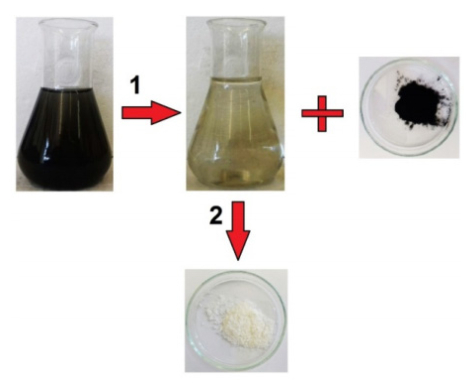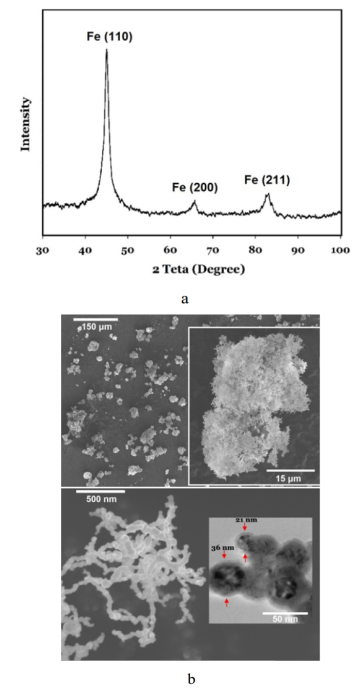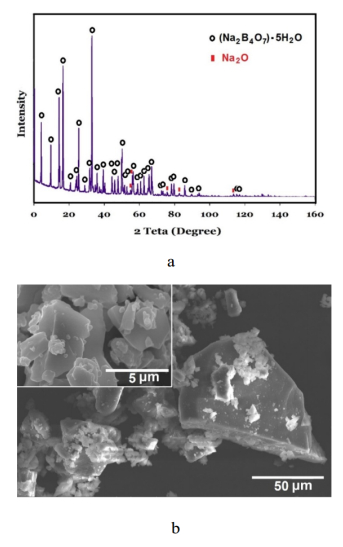1. Introduction
Sodium borate (Borax, Na2B4O7) is an important naturally-occurring boron mineral which has historically been used in pharmaceutical applications because of its preventative and healing properties. borax pentahydrate, (Na2B4O7)·5(H2O), is the most common form of sodium borate which is commercially mined from its deposits by the repeated evaporation of seasonal lakes in large quantities in several countries for use in a wide variety of applications, including in the metallurgical processing of steel, non-ferrous and amorphous metals, welding fluxes, and plating compounds as well as in ceramics, laundry detergent boosters, cleaners, preservatives, dispersal agents and as filler in composite materials [1]. It can also be used as shielding material in nuclear applications, due to its high ability for adsorption of nuclear emissions [2], crosslinking additive in the processing of biomaterials [3], and corrosion resistance coatings [4]. Moreover, borax pentahydrate can be employed for the dissolution of other boron containing compounds such as ulexite [5], the production of anhydrous borax which is used for the preparation of sodium borohydride, an important hydrogen storage material, and also for the boron recovery [6]. Currently, borax is commercially produced from boron-containing minerals by a variety of methods [7]. Considering its wide range of applications and the limited natural boron resources, the production of borax from new raw materials is important, as also pointed out in the work of Çilek and Üresin (2005) [8]. Obviously, the synthetic preparation of borax, particularly from waste materials, can be of significant interest. Here we propose a facile process for the preparation of borax pentahydrate from waste residual material produced during the production of Fe nanoparticles. The latter is an interesting emerging material for the effective removal of various organic [9,10] and inorganic [11] contaminants, such as Cr [12] and 2, 4-dichlorophenol [13] from waste waters. Liquid-phase reduction is the most applied method for the synthesis of Fe nanoparticles involving the utilization of the precursors such as iron salts (namely FeCl3·6H2O) and the reductants (mainly NaBH4) leading to the production of Fe nanoparticles as the final product as well as boron containing waste materials [14]. Despite its high efficiency, however, the economic viability of using Fe in purification purposes is still a challenge due to its high preparation costs. This limitation may be mitigated if the waste materials produced can be used for the preparation of other economically valuable materials. In this regard, innovation in high yield methods such as sodium borohydride reduction which can be precisely controlled by monitoring the synthesis conditions [14] in terms of recovery of the by-products can make such methods more attractive for environmental applications. Moreover, there are environmental concerns related of the release the boron containing wastes in the environment [15]. Hence, valorization of the remaining wastes can be techno-economically beneficial leading to the wider application of Fe nanoparticles.
2. Experimental and materials
In this research, Fe nanoparticles were synthesized by the liquid phase reduction process [16]. For this, 250 ml solution containing 9.09 g sodium borohydride (NaBH4, ≥98.0%, Sigma-Aldrich) in deionized water was injected into 250 mL solution containing 200 ml ethanol, 50 ml deionized water and 5.40 g iron(Ⅲ) chloride hexahydrate (FeCl3·6H2O, ≥99%, Sigma-Aldrich) in a 500 ml three-open neck flask reactor. Subsequently, a black powder could be formed which was separated from the reaction solution by vacuum filtration using filter papers, followed by washing with ethanol and drying at 323 K overnight. The black powder was characterized to be Fe nanoparticles, as explained later in this paper. The remaining homogeneous waste solution obtained from the process of Fe nanoparticles production was used as the feed material for the preparation of valuable borax pentahydrate by the slow decomposition/evaporation method. For this, the waste solution was heated in an oven at 60 ℃ overnight leading to the evaporation of the liquid phase. A white powder was obtained which was characterized by different methods. Figure 1 shows photographs of various materials prepared in this study, illustrating the flowchart of the process. X-ray diffraction (XRD) and X-ray fluorescence (XRF) analyses were performed simultaneously using a Rigaku equipment. The crystallite size calculation was carried out based on the Scherrer equation:
where d, K, λ, β and θ are the average crystallite size, the dimensionless shape factor, the wavelength of the X-ray used, the full-width at half maximum intensity (FWHM) of the sample, and the Bragg angle, respectively. The purity of the final products was estimated using a Panalytical X'Pert Pro X-ray reflectometer. Transmission and scanning electron microscopy were conducted using a Hiatchi H9000na operated at 300 kV acceleration voltages, and a Hitachi S4100 microscope equipped with energy dispersive X-ray (EDX) detector, respectively.
3. Results and discussion
Figure 2a shows the XRD pattern of the Fe nanoparticles synthesized, indicating the formation of pure Fe with bcc crystalline structure. Figure 2b exhibits the electron micrographs of the sample.
The Low magnification SEM micrograph, shown in the upper panel, demonstrates the presence of agglomerated clusters with an average size of about 50 μm. The inset in Figure 2b (upper panel) confirmed that the micrometer sized agglomerated clusters have a porous structure consisting of nanometer sized Fe particles, as evidenced in the SEM micrograph exhibited in Figure 2b (down panel). The inset in this micrograph is a TEM bright field image indicating that the spherical Fe nanoparticles are less than 40 nm in size. Moreover, the TEM micrograph provides evidence that the nanoparticles have a core-shell structure comprising iron as the core and iron oxide as the shell, which is in line with the typical morphology of Fe nanoparticles particles used as high-performance contamination removal agents [17]. The broad XRD peaks observed in Figure 2a are due to small crystallite sizes of Fe nanoparticles, which were calculated to be about 13 nm using the Scherrer's equation. These results are in agreement with electron micrographs shown in Figure 2b.
The slow heating of the waste solution left from the process of producing Fe nanoparticles led to the formation of a white precipitate which was subjected to various characterisations. The XRD pattern of the sample prepared is presented in Figure 3a, based on which the major phase present in the sample can be found to be borax pentahydrate together with a small amount of sodium oxide as the minor phase. Figure 3 presents the SEM micrographs recorded on the sample. As can be seen, the material obtained is composed of particles with a wide size distribution from about 100 μm to submicrometre sized particles. The inset exhibits the morphology of finer ones, from which the flat surface and the irregular shapes of the particles is evident The EDX analysis further confirmed the formation of borax pentahydrate as the major phase. The mechanism of the phenomena taking place during the process is explained below. The reduction reaction of iron (Ⅲ) chloride hexahydrate by sodium borohydride leading to the synthesis of Fe nanoparticles has been suggested as Eq 2 [14]:
|
4FeCl3+3NaBH4+9H2O=4Fe+3NaH2BO3+12HCl+6H2(g)
|
(2)
|
Iron was separated from the solution product obtained from the reaction (2), leaving the waste solution behind. The formation of borax from the waste solution can be attributed to the decomposition reaction occurring during heating the waste:
|
4NaH2BO3=Na2O+Na2B4O7+4H2O
|
(3)
|
Borax (Na2B4O7) formed can then be hydrated in the presence of the remaining water exist in the system. The presence of diffraction peaks originating from Na2O phase in the XRD pattern of the final product (Figure 3a) confirms the mechanism proposed. Na2O can easily be removed from borax pentahydrate by simple washing of the product which causes the formation of highly soluble NaOH. The purity of the borax pentahydrate was also estimated 91% in the final products. Borax pentahydrate is the most widely used boron ore with a number of industrial applications. To the best of our knowledge, this is the first time that borax pentahydrate is synthesised using a waste material. The high potential applications of borax pentahydrate can make it an attractive by-product of the Fe nanoparticles synthesis process, reducing the total costs associated with the synthesis of Fe nanoparticles. It can also prevent the releases of toxic boron-containing substances to the environment which may cause several environmental and health problems. In conclusion, for the first time, borax pentahydrate, (Na2B4O7)·5(H2O), was successfully synthesized (with ~87% boron recovery) in laboratory from the waste solution remained from the synthesis of nanoscale Fe nanoparticles via liquid-phase reduction of FeCl3. The process employed involved the slow heating of the waste material leading to the decomposition of the waste into borax pentahydrate. This finding can considerably reduce the total cost of the Fe nanoparticles synthesis which may lead to its wider application. Further studies are required on the energy and yield balance of the process and also to the recovery of other by-products such as H2 from this process to be more economical and efficient. Cost-benefit analysis of this process is also welcome for the future studies.
4. Conclusion
Application of zero valent iron materials for the removal of environmental persistent contaminants has been considerably increased in the recent years. However, the cost of the synthesis of these materials and relatively high amount of the wastewaters produced are the main existing challenges in this regard. In this paper, we have proposed a facile method for the recovery of the effluents by production of borax pentahydrate with a number of industrial applications. Using this method, the mentioned problems associated with the use of iron nanoparticles can be overcome.
Acknowledgements
National Natural Science Foundation of China (Grant No. 51750110513) is appreciated for providing the financial support. Thanks are also due to FCT for the doctoral scholarship No. SFRH/BD/103695/2014 for the first author.
Conflict of interest
The authors declare there are no conflicts of interest in this paper.










 DownLoad:
DownLoad: 







